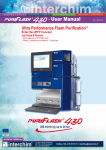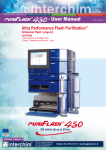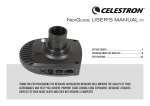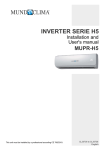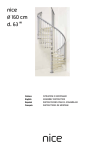Download Parkside PFS 710 User's Manual
Transcript
PFS 710 Operation and Safety Notes Operation and Safety Notes............................................................................................... Page 5 a k i b c j d e h A g f B C l m n o D E F Kompernaß GmbH Burgstraße 21 · D-44867 Bochum (Germany) Last Information Update: 10 / 2006 · Ident.-No.: PFS710-102006-2 / UK / IE Table of Content Before reading, unfold the page containing the illustrations and familiarise yourself with all functions of the device. The following icons / symbols are used in this instruction manual: Read instruction manual! V~ Voltage Observe caution and safety notes! Wear protective gloves, safety goggles, ear protection and particle mask Beware of electrical shock! Proper procedure and handling! n0 Rated idle running speed Protection category II power tool W Watt (performance) Introduction Your safety................................................................................................................ Page Proper use................................................................................................................ Page Technical information................................................................................................ Page Items supplied.......................................................................................................... Page Features of the PFS 710........................................................................................... Page 6 6 6 6 6 Safety General Safety Information....................................................................................... Page Workplace-Safety..................................................................................................... Page Electrical Safety........................................................................................................ Page Safety of Personnel................................................................................................... Page Diligent Interaction and Use of Electrical Hand Tools................................................. Page Service..................................................................................................................... Page Original ancillaries / and accessories......................................................................... Page Attention - Service lines!.......................................................................................... Page Understood everything?............................................................................................ Page Important safety instructions specific to the tool...................................................... Page Information about saw blades................................................................................... Page 6 7 7 7 8 8 8 8 9 9 9 Before taking into use Inserting / replacing saw blades................................................................................ Page 9 Blade speed setting wheel........................................................................................ Page 10 Setting the oscillation action..................................................................................... Page 10 Preparing the saw for use uiding the sabre saw safely and accurately............................................................ Page 10 G Switching On and Off................................................................................................ Page 10 Advice about ways of working when sawing............................................................. Page 10 Cleaning. .................................................................................................................... Page 11 Disposal...................................................................................................................... Page 11 Information Service..................................................................................................................... Page 11 Declaration of conformity / Manufacturer.................................................................. Page 12 GB/IE 5 Introduction / Safety Sabre saw PFS 710 L L Introduction 1 Sabre Saw PFS 710 1 Allen key 4 Sawblades 1 Operating manual 1 Booklet „Guarantee and Service“ All-purpose saw for house and garden L Your safety Please make sure you familiarise yourself fully with the way the device works before you use it for the first time and that you understand how to handle electrical power tools correctly. Further details can be found in the operating instructions. Keep these instructions in a safe place. If you pass the device on to anyone else, please ensure that you also pass on all the documentation. L Items supplied Features of the PFS 710 a Blade speed setting wheel b Locking button c On / off switch d Oscillating action rotary switch eHexagonal socket head screw key for saw blade exchange fHexagonal socket head screw for saw L Proper use The tool is intended for sawing, cutting to length or trimming of securely supported objects made of wood, plastic and building materials. The sabre saw is suitable for rough sawing work, straight and curved cuts and sawing flush. Please heed the information on saw blades and the advice on ways of working. The tool is not intended for commercial use. Any other use or modification of the tool shall be considered as improper use and could give rise to considerable risk of accident. The manufacturer will not accept liability for loss or damage arising from improper use. g h i j k l m n o blade exchange Footplate Saw blade Plunger Locating pin Clamp plate Saw blade for wood (quick, coarse cuts) Saw blade for wood (quick, coarse cuts) Saw blade for wood (fine cuts) Flexible Universal-Sawblade L Safety L Technical information Nominal voltage: Nom. power input: Nom. no-load speed: Blade stroke: Cutting capacity max.: Weight: Protection class: Sound pressure level: Sound power level: Acceleration: 6 GB/IE 230 V ~ 50 Hz 710 W n0 500 - 2600 rpm 28 mm wood 195 mm 3.5 kg II / 86 dB (A) 99 dB (A) 4.5 m / s2 General Safety Information JAttention! The following fundamental safety measures are to be observed for your protection against electrocution and the dangers of personal injury or fire when using electrical hand tools. JRead and take note of these safety instructions before using the appliance for the first time, and have them readily available at all times. Failure to strictly observe these safety instructions could lead to electrocution, fire and / or serious personal injury. Safety L Workplace-Safety J a potential danger of explosions of inflammable liquids, gases or dust. Electrical hand tools produce sparks which could ignite the dust or vapours. J When using electrical tools, ensure that children and other persons are not in the close vicinity. In the event of distraction you could lose control over the appliance. Damaged appliances, power cables and plugs mean potential fatal injury through electrocution. Regularly check the condition of appliances, power cables, power plugs and, if required, chargers and power packs. JNever take an appliance that has damaged components into operation. Immediately remove the plug from the socket. J Warning! Never open the appliance. JArrange for repairs and parts-exchanges to be carried out only by the service department or an electrical specialist. L L JKeep your workplace clean and tidy. Disorder and poorly lit working areas can lead to accidents. JDo not use this appliance in areas where there is Electrical Safety Avoid fatal risks through electrocution: JThe connecting plug of the appliance must fit into the plug socket. Under no circumstances may the plug be altered. Do not use adapter plugs together with earthing-protected appliances. Unmodified plugs and suitable wall sockets reduce the risk of electrocution. JAvoid bodily contact with earthed surfaces, such as pipes, radiators, ovens and refrigerators. There is an increased risk of electrocution if your body is earthed. JWarning! Protect the appliance from rain and moisture. The entry of water into an electrical appliance increases the risk of electrocution. JDo not misuse the electrical cable, e.g. to carry the appliance, suspend it in storage or to pull the plug from the socket. Keep the cable away from heat, oil, sharp edges or appliance components in motion. Damaged plugs or tangled cables increase the risk of electrocution. JCaution! Regularly check the connections of electrical hand tools and, if damage is discovered, arrange for them to be repaired by a recognised specialist. JWhen working outdoors, only use extension cables that are approved for use outdoors. The use of an extension cable suitable for employment outdoors reduces the risk of electrocution. Safety of Personnel JAlways be attentive and always be aware of what you are doing. Work sensibly with an electrical hand tool. Do not use the appliance if you are unconcentrated or tired or influenced by drugs, alcohol or medications. Just a simple lapse of attention in the use of an electrical hand tool is sufficient to lead to serious injuries. J Wear personal protection equipment and always a pair of protective glasses. The wearing of personal protection equipment, such as a dust mask, anti-slip safety shoes, protective gloves, hard hat and hearing protectors, dependant on the type of electrical hand tool and its employment, reduces the risk of injuries. JAvoid unintentional operation of the appliance. Ensure that the switch is in the „OFF“ Position before inserting the plug into the power socket. If you have a finger on the ON / OFF switch when carrying the appliance, or plug it in when it is already switched on, this can lead to serious accidents. JRemove the adjusting tool or screwdriver before switching the appliance on. A tool or key that is in a revolving motor component could, when thrown out, lead to potentially serious injuries. JDo not overestimate yourself. Ensure that you are standing firmly and maintain your balance at all times. You can thus control the appliance better, especially in unexpected situations. GB/IE 7 Safety JWear suitable clothing. Do not wear loose clothing or jewellery. Keep your hair, clothing and gloves well away from moving components. Wear a hairnet if you have long hair. Loose, not well-fitting clothing, jewellery and long hair can become caught up in moving components. JUse dust suction and / or collection units if these can be assembled. Thereby take note that the dust collection units fitted must be suitable for this particular area of application. The correct use of these equipments reduces potential dangers caused by dust. JImmobilise the workpiece securely. Use clamps / vices to firmly hold the workpiece. It is thus better secured than just with your hand. appliance. Many accidents have their origin in poorly maintained electrical hand tools. JKeep cutting tools sharp and clean. Carefully maintained cutting tools with sharp cutting edges jam less often and are easier to guide. JKeep hand grips dry, clean and free from oil and grease. JUse electrical hand tools, accessories or ancillary components only in accordance with these instructions and in such a manner as is detailed for the particular types of appliance. Take consideration thereby of the working conditions and the task to be completed. The use of electrical hand tools for purposes other than those originally intended can lead to dangerous situations. LDiligent Interaction L and Use of Electrical Hand Tools JDo not overburden your electrical tools. Use the electrical hand tool that is applicable to the work to be done. It works better and safer in the pre-determined area of performance. JNever use an electrical hand tool that has a defective switch. An electrical hand tool that can no longer be switched on or off is dangerous and must be repaired before being used. JRemove the plug from the socket before making adjustments on the appliance, changing ancillaries or putting it into storage. These precautions prevent the unintentional starting of the appliance. JStore unused electrical hand tools out of the reach of children. Do not permit individuals to use appliances if they are not informed about the interaction with them or they have not read these instructions. Electrical hand tools can be dangerous when in the hands of inexperienced people. JMaintain the appliance with care. Check to see that all moving parts are free-running and do not jam. Regularly check to see if components are broken or so worn and / or damaged that they have a negative influence on the performance of the appliance. Arrange for damaged components to be repaired before using the 8 GB/IE Service JPermit your appliance to be repaired only by qualified specialists and only with original spare parts. Thus, you can be certain that the safety of your appliance is assured. JPermit the exchange of plugs and power cables to be carried out only by the manufacturer of the hand tool or his authorised customer service. Thus, you can be certain that the safety of your appliance is assured. LOriginal ancillaries / and accessories jUse only the ancillaries and accessories detailed in the operating instructions. The use of ancillaries and accessories other than those detailed in the operating instructions could mean the risk of injuries for you. Attention - Service lines! JAttention! Take steps to ensure you do not, resp. cannot, damage electrical, gas or water service lines when working with electrical power tools. If necessary, carry out a check with a cable / pipeline detector before boring or cutting into a wall. Safety / Before taking into use L Understood everything? JWhen you have made yourself familiar with these general safety instructions for electrical hand tools, and, with the help of the appropriate operating instructions, are familiar with the functions and handling of your electrical hand tool, then you can start with the work. Then, you will work at your safest under consideration of the declarations and instructions of the manufacturer. Important safety instructions specific to the tool J Do not cut materials containing asbestos. JWhen sawing building materials, observe the statutory requirements and the manufacturer’s recommendations. JCaution! Never allow the blade to come into contact with a solid object or the floor when the tool is operating – danger of kick-back! JMake sure that the tool is operating before you bring it into contact with the workpiece. JThe course of the cut must have no obstructions above or below it. When you switch on the tool, ensure that the blade is not resting on, interfering or in contact with any object. The footplate g must always be set against the workpiece when the tool is sawing. JHold the tool firmly with both hands at all times when working. Keep proper footing and balance. JDo not put the tool down before it has been switched off and has reached a standstill. JCaution! Do not remove the saw blade from the workpiece until it has come to a standstill – danger of kick-back! JUse only sharp, defect-free blades. Replace cracked, bent or blunt blades immediately. L Information about saw blades The Parkside basic equipment already contains saw blades for the most common main applications. You can also use all other saw blades, assuming they are provided with a suitable 1/2“ universal shaft receptor. Optimal saw blades suitable for all application purposes for a sabre saw are available in various lengths from traders overall. Note: TPI = teeth per inch / 2.54 cm Wood-sawing blade l : Dimensions: 240 x 1,5 mm, 5 TPI Best suitability: for sawing nail-free rough wood up to 190 mm in a fast rough cut Wood-sawing blade m : Dimensions: 240 x 1,5 mm, 3 TPI Best suitability: for sawing rough wood, also firewood, up to 190 mm in a fast rough cut. Universal saw blade n : Dimensions: 150 x 1,25 mm, 6 TPI Best suitability: for sawing building timber, plywood, blockboard and chipboards, also for plunge cuts. Flexible saw blade o : Dimensions: 150 x 0,9 mm, 10 TPI Best suitability: for sawing wood, also with nails, as well as plastics. L Before taking into use L Inserting / replacing saw blades jRemove the mains plug from the socket before carrying out any tasks on the tool! j Protect yourself from being injured by sharp blades. Wear appropriate protective gloves when fitting and testing the blade. j Before replacing the blade, make sure that it is free of any cutting residue (e.g. wood splinters). j If necessary, clean out the saw blade mounting recess with a thin paintbrush or by compressed air. 1.Unscrew the hexagonal socket head screw f using the supplied hexagonal socket screw key e. 2.Feed the saw blade between the plunger i and the clamp plate k. Make sure that locating pin j engages in the GB/IE 9 Before taking into use / Preparing the saw for use mounting hole in the saw blade. The blade must not pull out. 3.Firmly retighten the Allen screw f. Check that the saw blade is fixed safely and firmly before taking the appliance into operation. L Blade speed setting wheel With the adjusting wheel a you can pre-select the desired number of strokes (Number of to and fro movements) (MIN. = smallest number of movements, MAX. = largest number of movements). The blade speed can also be selected whilst you are using the tool. L Setting the oscillation action With adjustment of the shuttling, using the rotary switch shuttling d you can match the operation of the saw blade to the material to be worked on. Setting 0 (oscillation action is switched off): This setting is suitable for sawing soft or hard materials. This setting can also be used to produce clean-cut edges. Setting I: Suitable for materials of medium strength, e.g. hardwood, plastic. Setting II: Use this setting when you are sawing soft materials such as lightweight building or insulation materials. Setting III: Set the rotary switch in this position if you are cutting softwood / pruning trees or soft materials. L Preparing the saw for use The mains voltage at the plug must match that shown on the rating plate on the tool. Equipment shown as 230 V ~ can also be used on 220 V ~ supplies. 10 GB/IE L G uiding the sabre saw safely and accurately The shoe g pivots to adjust to the workpiece and provides safe support to the tool. It must always be set against the workpiece when the tool is in use. L Switching On and Off You can choose between short and permanent functioning for the operation. For brief work use the short function setting and for extended work use the permanent function setting. Switching on short function operation: j Press the On / Off switch c. Switching off short function operation: j Release the On / Off switch c. Switching on permanent functioning: jPress the On / Off switch c and hold it in this position with the retaining button b. Switching off permanent functioning: j Press the On / Off switch c and then release it. L A dvice about ways of working when sawing J Before sawing, always check the workpiece for foreign bodies such as nails, screws etc. and remove them. J Do not allow the ventilation slots to become covered. J Switch the tool on and only then bring it into contact with the workpiece. J If the saw blade jams, switch off the tool immediately. Open the sawn split in the workpiece slightly using a suitable tool and extract the saw blade. jAlways make sure the saw blade type and the blade speed and oscillation settings are suitable for the workpiece. j Narrow blades are best for tight curves. Preparing the saw for use / Cleaning / Disposal / Information j The footplate g must always be set against the workpiece surface. j Saw through the workpiece using even pressure and speed of progress. Flush sawing: With so-called elastic bi-metallic saw blades, presupposing the appropriate length, projecting workpieces such as pipework protruding from the wall can be sawn off adjacent to the wall (see also Fig. D). Follow these steps: 1.Place the saw blade directly on the wall surface. 2. Bend the blade by sideways pressure so that the footplate g comes up against the wall. 3.Switch on the tool as described above and trim the workpiece using constant sideways pressure. j Never permit fluids to permeate inside the ap- pliance. Use a soft cloth to clean the appliance housing. Never use fuel, solvents or cleansers which attack plastic. j Clean out the saw blade mounting recess by tapping the tool lightly (without an inserted saw blade) by the footplate g on a level surface. Clean any remaining dirt from the saw blade mounting recess using a thin paintbrush or compressed air. L Disposal The packaging is made entirely of recyclable materials, which you may dispose of at local recycling facilities. Do not dispose of electrical appliances in household waste! Plunge sawing: Plunge sawing can be used only in soft materials (such as wood etc.). Follow these steps: 1.Place the sabre saw onto the workpiece. Ensure that the lower edge of the footplate g is resting on the upper surface of the workpiece. Switch the appliance on. 2. Slowly cut into the workpiece with the saw blade. 3.Place the sabre saw upright and saw further along the cutting line as soon as you have reached the required depth. 4.At the end, switch the sabre saw off and remove it from the workpiece. L Cleaning In accordance with European Directive 2002 / 96 / EC on used electrical and electronic appliances and its implementation in national law, used power tools must be collected separately and recycled in an ecologically compatible manner. Information on options for disposing of electrical appliances after their useful life can be obtained from your local or city council. L Information L Service Details of the Service Centre responsible for your region are shown in the warranty documents. Always remove the plug from the power socket before cleaning the appliance. j Always keep the tool and the ventilation slots clean. This will maximise the service life of the tool and ensure your safety. j Clean the saw frequently. For best results, do this immediately after you have finished using it. GB/IE 11 Information L D eclaration of conformity / Manufacturer We, Kompernaß GmbH, Burgstr. 21, D-44867 Bochum, Germany, hereby declare that this product conforms with the following EC regulations: Machinery Directive (98 / 37 / EC) EU Low Voltage Directive (73 / 23 / EEC) Electromagnetic compatibility (89 / 336 / EEC) Description / Model type: Parkside Sabre saw PFS 710 Bochum, 31.10.2006 Hans Kompernaß - Managing Director - We reserve the right to make technical modifications in the course of further development. 12 GB/IE










